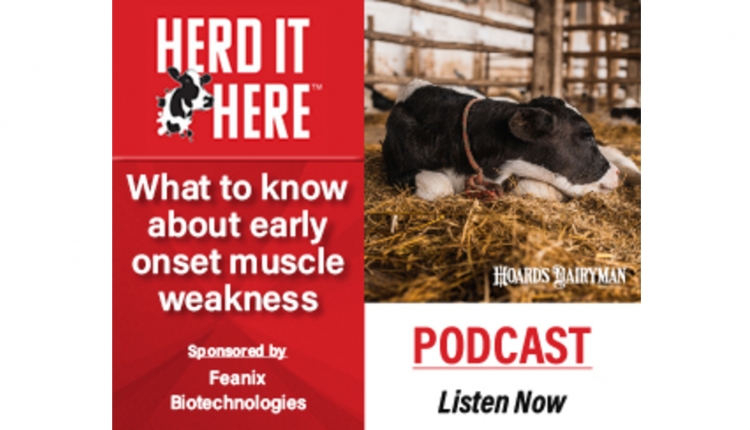
The author is an associate professor of dairy cattle genetics at Penn State University.
The dairy faculty at Penn State launched a dairy MOOC (Massive Open Online Course) this past spring that includes a genetics section. The most frequent topic for the genetic discussion board relates to A2 milk, which I had not included in the course materials. It is also a subject that comes up at producer meetings on occasion and deserves discussion.
For those who are unfamiliar with the A2 milk discussion, beta casein comprises approximately one-quarter of milk proteins. There are multiple versions of the beta casein gene, and the most predominate type centers around the A2 discussion.
Mutations to the beta casein gene result in several other forms of which A1 is the most common. The “B” version is somewhat common and is similar to A1. A2 is considered the more “natural” form of beta casein. Other types are more common in cattle than in humans and other species, though — and contrary to popular belief — other forms of beta casein are found in humans. Beta casein is a 224 chain amino acid protein, and the A1 version has one amino acid that is different from A2.
Brewing debateThe controversy surrounding A1 versus A2 relates to the digestion of beta casein. When proteins are digested, bioactive peptides can be released. A peptide is simply a small chain of amino acids. For example, oxytocin is a nine amino acid peptide.
A fragment of beta casein called BCM-7 (β-casomorphin-7) is a seven amino acid peptide that is thought to be much more commonly released when A1 beta casein is digested than when A2 is digested.
BCM-7 has opioid-like properties that are suggested to affect up to 25 percent of the human population. It is unclear why some people appear more sensitive than others.
The scientific community is not in complete agreement on the human health effects of drinking A1 versus A2 milk. It was suggested that A1 milk could lead to immune processes that contribute to diabetes, heart disease, autism, and schizophrenia. An early research trial appeared to support the diabetes hypothesis, but subsequent trials that were much larger and more controlled did not provide any such evidence. This encouraged many — myself included — to view the health benefit of A2 as an unsupported hypothesis and likely spurious.
However, there are newer research trials that warrant our attention and monitoring. Rodent trials have studied the difference of A1 versus A2 milk on gut inflammation and report more inflammation when the mice or rats consumed A1 milk. Likewise, human studies have suggested higher levels of gastrointestinal discomfort following consumption of A1 milk than A2 milk. Study participants were unaware of which type of milk they were consuming.
Many people who believe they are “lactose intolerant” could actually be sensitive to A1 beta casein. These studies need to be replicated with larger sample sizes and in different research labs before I am willing to state definitively that A2 milk is better for human digestion or health. I do not think the current research can simply be dismissed, though.
Genetics in actionBeta casein genetics are different from the standpoint that there is not a dominant or recessive gene. Cows with two copies of A1 will produce only A1 beta casein and those with two copies of A2 will produce only A2. Those cows that inherit A1 from one parent and A2 from the second will produce a mix of A1 and A2 beta casein in their milk. For this reason, cows must be homozygous A2 to be considered “A2 milk” producers.
The frequency of the A2 allele appears to be around 60 percent in Holsteins. This means that about 36 percent of Holsteins produce A2 milk, 48 percent produce a mix of A1 and A2 milk, and 16 percent produce exclusively A1 milk. Other breeds have a higher proportion of A2. Guernseys are thought to be highest with a frequency of A2 milk reported to approach 90 percent; in order to more fully capitalize on their advantage, the Guernsey breed associations of some countries do not allow bulls homozygous for A1 to enter into A.I. service.
Marketing channelsA2 milk products are licensed and marketed in the United States by the a2 Milk Company based in New Zealand. The company owns the patent for testing A2 and, for this reason, producers cannot simply test their cows and market their own milk as A2 but must contact the company to obtain license rights. This creates an advantage for some Guernsey breeders as they are able to market milk based on the high frequency of A2 milk in the breed without A2 testing. The a2 Milk Company sources their milk from many different types of farms, including larger Holstein herds that milk homozygous A2 cows as a separate string. Currently, a half-gallon of A2 milk sells for a similar price to a half-gallon of organic milk.
Marketing efforts by the a2 Milk Company in the United States began in 2015, but it has been active in Australia and New Zealand for over a decade. A2 milk currently commands about 9 percent of the Australian grocery market. Fluid milk presently is the primary A2 product, but infant formula and other products have begun to enter the market.
Admittedly, how we as dairy cattle breeders handle the A2 milk story is fraught with uncertainty. No dairy farmer wants to ignore legitimate human health concerns. On the other hand, we can’t afford to constantly change direction in our genetic selection program to address tenuous health claims.
There are two related considerations when deciding how much emphasis to place on A2 genotype. The first is whether you are, or expect to soon be, marketing A2 milk. If so, the decision is easy. You will be using sires that are homozygous for A2 almost exclusively.
The more difficult question to address is whether A2 milk will become the market expectation rather than the exception. We have seen this happen with rBST-free milk in many parts of the country. This could occur if additional research supports the health claims of A2 milk. The challenge is that we can’t simply convert our cows to all A2 — the process of selective breeding takes time.
For this reason, I think it is advisable to factor A2 in your herd’s selection program. I do not think it is necessary to eliminate non-A2 bulls from consideration. However, if two bulls are similar for those traits that I most value and one is A2, I would select the A2 sire. Steadily raising the frequency of A2 now will cause less disruption to your herd if your milk market shifts in that direction in the future.
Regardless of the direction the A2 milk market heads, it may represent a shift in how we view milk quality. Rather than crude measures of component percentages and yield, we may increasingly consider the quality of protein and fat we produce.









